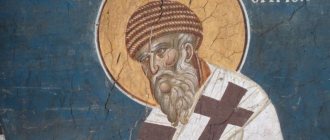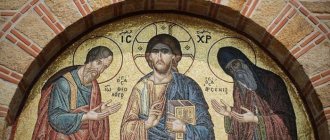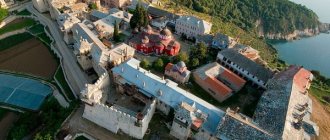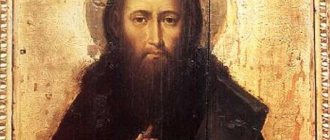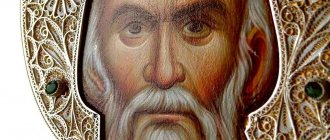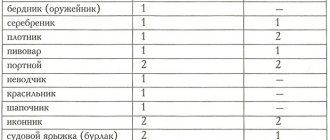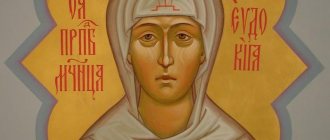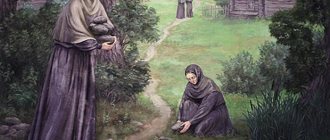| First Martyr and Archdeacon Stephen |
Stephen
(c. - c.), apostle from the age of 70, archdeacon, first martyr Memory: January 4 at the Cathedral of the Seventy Apostles, August 2 on the day of the transfer of the relics, September 15 on the day of the discovery of the relics, December 27.
Saint Stephen, an apostle of seventy, came from Jews who lived abroad, that is, outside the Holy Land. Such Jews were called "Hellenists" because they were heavily influenced by the Greek culture that dominated the Roman Empire. The service and martyrdom of Stephen was described by the Evangelist Luke in the book of the Acts of the Apostles, chapters VI-VIII.
After the descent of the Holy Spirit on the apostles, the Church began to grow rapidly, and the need arose to take care of orphans, widows and the poor in general who had been baptized. The twelve apostles invited Christians to select seven worthy men to care for those in need. Saints Stephen, Prochorus, Nicanor, Timon, Parmen, Philip and Nicholas were ordained deacons (which means “helpers”, “servants”), becoming the closest assistants to the apostles from the twelve. Among the deacons, young Stefan stood out for his strong faith and gift of speech, called archdeacon, i.e., first deacon. Soon the deacons, in addition to helping the poor, began to take an intimate part in prayers and divine services.
Stephen preached the word of God in Jerusalem, supporting the truth of his words with signs and wonders. His success was very great, and this aroused the hatred of the Pharisees against him. They grabbed him and dragged him to the Sanhedrin. Here the Pharisees presented false witnesses who claimed that in his sermons he insulted God and the prophet Moses. In his justification, Saint Stephen outlined the history of the Jewish people before the Sanhedrin, showing with vivid examples how the Jews always resisted God and killed the prophets sent by Him. The members of the Sanhedrin, listening to him, grew increasingly angry.
| Martyrdom of Chief Deacon Stephen |
At this time, Stephen saw Heaven open above him, and he exclaimed: “I see the heavens opened and the Son of Man standing at the right hand of God” (Acts 7:56).
Hearing this, the members of the Sanhedrin became very angry. Covering their ears, they rushed at Stefan and dragged him out of the city. Here, as the law commanded, the witnesses who first accused Stephen were the first to stone him. At the same time, there was a young man named Saul, who was entrusted with guarding the clothes of those stoning. He approved of Stephen's murder. In the distance, on a hill, stood the Mother of God with the holy Apostle John the Theologian and fervently prayed for the martyr. Falling under a hail of stones, Stephen exclaimed: “Lord Jesus! Do not impute this sin to them and accept my spirit.” So Archdeacon Stefan, at the age of about 30, became the first martyr for Christ for about a year. In the words of the third-century martyr Asterius, it was “the firstfruits of martyrs, the teacher of suffering for Christ, the foundation of a good confession, for before Stephen no one shed his blood for the Gospel.”
| Part of the chapter of the first martyr and archdeacon Stephen. Vatopedi Monastery. Athos |
Relics and veneration
After the death of the martyr in Jerusalem, persecution of Christians began, from which they were forced to flee to different parts of the Holy Land and neighboring countries. This is how the Christian faith began to spread in different parts of the Roman Empire. The blood of the first martyr Stephen was not shed in vain and his prayer for the non-imputation of sin to those who beat him was heard. Soon Saul, who approved of this murder, believed, was baptized and became the famous Paul - one of the most successful preachers of the Gospel. Many years later, Paul, visiting Jerusalem, was also captured by an angry crowd of Jews who wanted to stone him. In his conversation with them, he remembered the innocent death of Stephen and his participation in it (Acts 22:19) [1].
| Right hand of the Holy First Martyr and Archdeacon Stephen. Holy Trinity-Sergius Lavra. Serapion Chamber |
After the holy first martyr Archdeacon Stephen was stoned by the Jews, his holy body was thrown without burial to be devoured by animals and birds. However, on the second night, the famous Jewish teacher of the law Gamaliel, who began to lean toward faith in Jesus Christ as the Messiah and defended the apostles in the Sanhedrin (Acts 5:34-40), sent people loyal to him to take the body of the first martyr. Gamaliel gave him burial on his own land, in a cave not far from Jerusalem. When the secret disciple of the Lord, Nicodemus, who came to Him at night (John 3:1-21; John 7:50-52; John 19:38-42), died, Gamaliel also buried him near the tomb of Archdeacon Stephen. Then Gamaliel himself, who was baptized along with his son Aviv, was buried at the tomb of the first martyr Stephen and Saint Nicodemus.
| Finger of St. ap. First Martyr Archdeacon Stephen of the Kiev-Pechersk Lavra. Holy Assumption Cathedral. central aisle |
In 415, the relics of the saints were miraculously recovered and solemnly transferred from the village of Kafargamala to Jerusalem by Archbishop John, together with the bishops of Sebaste and Jericho [2].
From that time on, healings began to take place from the relics. In the churches of the Holy Land this transfer of relics is commemorated on August 2. Around 428, during the reign of the blessed Emperor Theodosius II the Younger, the relics of the holy First Martyr Stephen were transported from Jerusalem to Constantinople and placed in the church in the name of the Holy Deacon Lawrence, and after the creation of the temple in the name of the First Martyr Stephen, they were transferred there on August 2.
At the beginning of the 21st century, a significant part of the relics of St. Stephen remained in Greece, especially in the monasteries of Holy Mount Athos. In the Vatopedi monastery there were parts of the venerable head [3] and shoulder [4] of the first martyr. Parts of the right hand of the apostle - a gift from Emperor Theodosius the Younger - were kept in the Konstamonit monastery, dedicated to the first martyr [5]. Other small particles of his relics were located in the Athos monasteries of Zograf and Stavronikita [6]. Also in Greece, in the Meteora convent of the first martyr Stephen, there was another part of the head of the first martyr, donated to the monastery by one of the representatives of the ruling houses of the Danube principalities [7].
The Russian Orthodox Church also preserves parts of the saint’s relics. A piece of the right hand is in the Serapion Chamber of the Trinity-Sergius Lavra, and the finger is in the Kiev Pechersk Lavra, in a shrine with the image of the saint [8].
Among the revered icons of the saint, the miraculous icon in the Konstamonite monastery, dating from the 8th century, is known.
Seven deacons
Even during the life of the holy Archdeacon Stephen, the Greeks grumbled against the Jews, who were not pagans, but were people who lived according to the laws of Moses, but were separated by twelve tribes. Jews who knew the Hellenic language, but had not mastered the faith and morals, lived in Jerusalem and its surroundings. Even as Jews, they spoke Greek.
Discontent arose between the Christian Hellenes and the Jews of Jerusalem, since the widows of the former were assigned inferior work, worse food and clothing. However, they soon calmed down and stopped grumbling and complaining.
It was then that seven deacons were chosen - Phillip, Nicanor, Prochorus, Timon, Parmena, Stephen and Nicholas of Antioch. Their names indicate that they were from Hellenic countries, for their names are not Jewish. Stephen was a relative of Saul, who came from the city of Tarsus (Cilicia).
He could, like the apostles, lay hands on the sick and heal them. He was beautiful in face, but more beautiful in soul.
Prayers
Greatness
We magnify you, / the passion-bearing Saint Stephen, / and we honor your honest suffering, / which you endured for Christ.
Troparion, tone 4
You have been crowned with a royal crown / from the sufferings / you have endured through Christ Bose, / the first sufferer of the martyrs Stephen, / you have denounced the fury of the Jews. / I saw your Savior at the right hand of the Father, / pray to Him for our souls.
Troparion, tone 3
A fellow apostle / and a first-sufferer, / a servant of Christ, the most praised of Stephen, / having first completed the torment of the course, / he brought countless generations of people equal to the hero of Christ. / Moreover, as an apostle and supreme sufferer / honoring you, we pray: / pray to Christ God / to grant us great mercy.
Troparion, tone 4
You fought the good fight, / the first martyr of Christ and the apostle, and the archdeacon Stephen, / and you exposed the tormentors of wickedness. / You were stoned by the hands of the wicked, but you received the crown from the right hand above, / and you cried out to God: / Lord, do not put this sin on them.
Kontakion, tone 6
You were the first to be sown on earth by the heavenly Worker, / all-validated Stephen, / you were the first to pour out blood on earth for Christ, blessed one, / you were the first from him to wear a crown of victory in heaven, / the beginning of sufferers, / the crown of martyrs, the first sufferer.
Kontakion, voice 1
The Lord came to us yesterday in the flesh, / and the servant today comes from the flesh; / yesterday the Reign of the flesh was born, / today a slave is stoned: / For this reason the first martyr and divine Stephen dies.
First Martyr Archdeacon Stephen
Saint Stephen was the closest assistant to the 12 apostles and one of seven worthy men chosen by Christians to care for orphans, widows, the poor and those who had been baptized.
When our Lord Jesus Christ, after completing the sacrament of our salvation, ascended into heaven and from the Father sent down the Holy Spirit on the apostles in the form of tongues of fire (Acts 2:1-4), and the first church (Jerusalem) began to multiply, arose in it soon displeasure between Greek Christians and Jews. Here we do not mean those Greeks who worshiped idols and whom the Holy Scriptures usually called pagans. At that time, the pagans had not yet been given access to faith in Christ and the word of salvation was not preached to them, even after the murder of Archdeacon Stephen, it was not long before pagans were allowed into the assembly of the faithful. The first of the pagan Christians was Cornelius the centurion (Acts 10), but he was barely baptized by St. Peter, the Christians from the circumcised Jews were indignant that Peter went to the uncircumcised, and they grumbled at him until he told them about the vision that had happened to him - about the shroud lowered from heaven (Acts 11: 5-18). Then they calmed down and glorified God, saying:
- Apparently, God also gave the pagans repentance to life.
So, during the life of Saint Stephen, the Greeks grumbled against the Jews, not from among the pagans, but who were also from the Jews and kept the same law given by Moses, but were scattered throughout different countries (as the holy Apostle James writes in his epistle: “to the twelve tribes located in dispersion - to rejoice"
(James 1:1), and having adopted the Hellenic language (but not the faith and morals), therefore they were called Hellenes by those who lived in Jerusalem. In a similar way, Chrysostom expresses himself: “Greeks, about whom is spoken of in the book of the Acts of the Apostles, I believe, those who spoke Hellenic were called, simply because they spoke Greek, being Jews.” Among such Greek Christians, a murmur arose against the Jewish Christians of Jerusalem, a murmur because the widows of the Greeks were neglected in the daily assignment of services: either they were assigned lower work, or they were given a smaller and worse share of food and clothing.
In this state of affairs, the holy twelve apostles called all the then believers and said to them:
“It is not good for us to leave the word of God and worry about tables.” So, brethren, select from among you seven men filled with the Holy Spirit and wisdom, we will appoint them to this service, and we will constantly continue in prayer and the ministry of the word (Acts 6:2-4).
This proposal of the holy apostles was approved by the entire assembly of the faithful, who immediately elected: Stephen, a man full of faith and the Holy Spirit, Philip, Prochorus, Nicanor, Timon, Parmena and Nicholas, a native of Antioch.
The very names of these chosen ones show that they were not from those Jews who lived in Jerusalem, but from those who lived in Hellenic countries, for their names are not Jewish, but Hellenic. Of these, Stephen was a relative of Saul, who was later called by the Lord with the name of Paul to the faith and apostolic service, while Paul was from the city of Tarsus, in Cilicia. These seven men were therefore chosen from among the Hellenes to serve the poor widows, so that the Hellenes, who had hitherto grieved over the neglect of their widows, would finally calm down and stop complaining and grumbling.
All these chosen ones were brought to the apostles, and they prayed, laid hands on them and ordained them as deacons (ministers).
The first among them was Stephen, full of faith and strength, and therefore was called archdeacon. By the grace of God, he performed many signs and wonders among the faithful: and if his miracles are not mentioned in the Holy Scriptures, this is not at all surprising, for it is also said about the deeds of Christ the Lord Himself: “ If we were to write about this in detail, then, I think, The world itself could not contain the books written.”
(John 21:25). However, with good reason we can say that Saint Stephen, like the oldest apostles, laid hands on the sick, and they became healthy. In addition, he was a strong man in word and deed, he confirmed the faithful in the faith, but he denounced the unfaithful Jews, proving to them from the Law and the Prophets that they had unjustly, out of envy, killed the Son of God, the Messiah, who had been awaited for so many centuries. And when a dispute once broke out between the Jews, and the Pharisees, and the Sadducees, and the Greek Jews about our Lord Jesus Christ, and some said that He was a prophet, others that He was a flatterer, and others that He was the Son of God, Saint Stephen , ascending to an eminence, began to preach the good news to everyone about Christ the Lord, saying:
- Brothers of men! Why is irritation increasing among you, and all of Jerusalem being divided into parties? Blessed is he of you who believed in our Lord Jesus Christ, for He, in order to free us from our sins, came down from heaven and was born of the Most Holy and Most Pure Virgin, chosen before the foundation of the world, He took upon Himself and bore our infirmities and illnesses, gave sight to the blind, cleansed lepers, cast out demons.
Having heard his words, they began to argue with him, strengthened their efforts to refute him and blaspheme the Lord he preached, as it is written about this in the book of the Acts of the Apostles:
- “Some of the so-called synagogue of the Libertines and Cyrenians, the Alexandrians, and some from Cilicia and Asia entered into a dispute with Stephen” (Acts 9:9).
For the Jews who lived among the Greeks in various distant countries had their own special synagogues in Jerusalem. And thus, in addition to the primary Jewish arch-synagogue, in Jerusalem there were many synagogues of various aliens, or Jews living in different countries, and from each country the Jews sent children exclusively to their synagogue in Jerusalem to learn the Law of God. And they themselves, coming annually to worship at the Temple of Solomon, lived in their synagogues, and gathered in them, and studied in them, as can be seen from the second chapter of the book of the Acts of the Apostles: “In Jerusalem there were Jews, pious people from every nation under heavens, Parthians, Medes and Elamites” and others (Acts 2:5-9), i.e. Jews who lived in Parthia, in Media, in Elam, and in other countries indicated there, now came to Jerusalem for the holiday. Accordingly, there were synagogues in Jerusalem: Cilician, Alexandrian, and Cyrene. They say about Libertina that there was a special tribe of Jews in it, descended from those who were once captured by Pompey of Rome, then released, and therefore were called “Liberians,” which means free. Likewise, St. Chrysostom says: “Those to whom freedom was granted by the Romans were called libertines. And since strangers from different countries lived in Jerusalem, they had their own synagogues in it, where they listened to the reading of the law and prayed.”
These meetings in synagogues - Libertine, Cyrene and others, arguing with Stephen, could not resist the wisdom and Spirit by which he spoke, and Saint Stephen at that time, with the word of truth, overcame three parts of the world - Europe, Asia and Africa, overcame Europe in represented by the Libertines, who came from Rome, located in Europe, defeated Asia in the person of the Cilicians, natives of Asia, defeated Africa in the person of the Cyreneans and Alexandrians, who came from Africa.
They, not having the strength to say anything against the truth preached by Stephen, the brightest of the sun, were inflamed with anger at him and, full of envy, taught some of their like-minded people, accustomed to telling lies, to declare to the main Jewish arch-synagogue that they had heard Stephen speak blasphemous words. speeches against Moses and God. Having thus outraged the people, the elders, and the scribes, they attacked Saint Stephen, seized him and brought him to the synagogue to the high priests and a great multitude of teachers of the law; They immediately presented false witnesses who stated:
“This man does not cease to speak blasphemous words against this holy place and against the law, and we heard him say that Jesus of Nazareth will destroy this place and change the customs that Moses established for us.
Saint Stephen stood calmly in the midst of this murderous assembly, like an angel of God, shining with the light of divine grace, like Moses once did: for the appearance of his face was transformed, and everyone in the assembly, looking at him, saw his face like the face of an angel.
The high priest asked him:
– Is what the witnesses say about you true?
The saint, opening his lips, made a long speech. He began with Abraham, who first received the promise of the coming of the Messiah, and then told the whole story up to Moses, remembering him with complete reverence and respect, and thereby clearly showed and objected to false witnesses that he himself was not at all a blasphemer either of Moses or of the Law God, given through Moses, and proved even more clearly that it was their fathers who were the blasphemers.
“Our fathers did not desire,” he said, “to be obedient to him, but rejected Him and turned their hearts to Egypt (Acts 7:39).
Then, objecting to another slander, as if he was blaspheming a holy place, he said:
– Solomon built a temple for Him (Acts 7:47).
With these words, he seemed to want to say: “I honor the holy place, wisely built by God’s favor by King Solomon and sanctified by the glory of the Lord, revealed by the cloud, I honor the temple, created by people for the glory of God, but at the same time I confess that God loves more to dwell in immaterial, not made by hands temples, i.e. in pure human souls.
“The Most High does not live in temples made by hands,” he said, “as God says through the prophet: “Heaven is My throne, and earth is My footstool; Where will you build a house for Me, says the Lord: and where is the place of My rest? for My hand has done all these things” (Isa. 66:1-2).
Finally, filled with divine jealousy, as once Elijah was, Saint Stephen addressed an accusatory speech against the entire assembly:
– Stiff-necked people with uncircumcised hearts and ears! You always resist the Holy Spirit: like your fathers, so do you. Which of the prophets did not your fathers persecute? They killed those who foretold the coming of the Righteous One (the promised Messiah), whom you have now become traitors and murderers (Acts 7:51).
These words of the saint aroused inexpressible rage in the high priest and the scribes, and all of them, hearing this, tore their hearts and gnashed their teeth at him.
But Stephen did not pay attention to their anger, for he was filled with the Holy Spirit, which made him courageous and inspired by God. Looking up to the sky, he saw the glory of God. Hitherto he had been imbued only with the desire to see her, and with full faith he firmly hoped to achieve this, but now, even before his death, he began to contemplate her and, as one close to death, met her as the beginning of bliss; he saw Christ Jesus Himself, His Lord and Lord, standing in heaven and, as it were, awaiting His coming to Himself, when, finally, having been released from the body, He would quickly come to Him, and where He, the Lord Himself, there is His servant will.
And what he saw he announced to everyone, exclaiming in a loud voice:
- Behold, I see the heavens opened and the Son of Man standing at the right hand of God (Acts 7:56).
He did not hide this vision, as holy men usually did, who, of course, in their humility, did not reveal the phenomena sent to them from God, but announced a glorious revelation to everyone so that the faithful would be confirmed in the faith, and the unfaithful would be put to shame. And for this reason he also did this, so as to assure those who would come after him as martyrs that those who suffer for Christ have no obstacle to ascending to heaven or any test, but a straight, free path is open, heaven is open, reward is ready. The Hero himself, standing, waits; The Lord's glory itself meets the martyr at the gates of heaven. And therefore the holy first martyr told everyone what he saw, as if calling others after him to the same crown of martyrdom.
But the envious Jews, accustomed to killing the prophets and rebelling against the Lord Himself, the Fulfiller of the Law and the Prophets, could not tolerate the words of truth, being themselves false, and did not want to listen to the revelations of Saint Stephen, but raised a loud cry, began to stop their ears and, unanimously rushing to him , laid their murderous hands on him, took him out of the city, as before the Lord Jesus, who deigned to suffer outside the walls, and stoned the good and faithful servant of the Lord. And to make it easier to throw stones at the saint, the false witnesses and murderers took off their outer garments and laid them at the feet of one young man named Saul, who, although he was a fellow tribesman and relative of the one being killed, was more irritated against him than others, out of blind jealousy of the Old One. Law. Saul, it says in Acts, approved of his murder (Acts 8:1). And St. John Chrysostom speaks about it this way: “Saul grieved that he did not have many hands so that he could hit Stephen with all of them, and was pleased only that the martyr was beaten by the many hands of false witnesses whose clothes he was guarding.”
At the very time when Saint Stephen was killed in the Valley of Issaphat (which lies between Jerusalem and Olivet, by the Cedar Stream, which had many stones along its banks), in the distance, on some elevation, looking from the mountain, stood the Most Pure Virgin with Saint John the Theologian and diligently She prayed for Stephen to the Lord and His Son, that He might strengthen him in patience and accept his soul into His hands. Oh, how sweet, although from cruel blows with stones, was the death of the holy first martyr, when from the heavenly heights the Sweetest Jesus, and from the earthly mountain the Sweetest Mother and her beloved disciple looked at his feat! And Saint Stephen, under the frequent rain of stones falling on him, all stained with blood, weakening in strength, and freed from the bonds of the flesh, his heart grieved not for himself, but for those who killed him, and more diligently for them than for himself, he prayed before his death: for about himself, standing upright, he said:
– Lord Jesus, receive my spirit (Acts 7:59).
Then, kneeling down, he prayed for his murderers, exclaiming:
- Lord, do not hold this sin against them (Acts 7:60).
With these words, the saint betrayed his pure soul to Christ.
This is how the good ascetic died, this is how the first martyr was crowned, as if with crimson flowers, with bloody stones, and entered the open sky he saw to the Lord and King of glory, to reign with Him in the endless kingdom.
He was ordained as an archdeacon by the holy apostles shortly after Pentecost, and suffered in the same year, after the Ascension of the Lord, on December 27, being a little over 30 years old. He was beautiful in face, but even more beautiful in soul.
His holy body was thrown down to be devoured by beasts and birds, and lay unburied day and night. And only the next night Gamaliel, a well-known Jewish teacher of the law in Jerusalem (who himself later believed in Christ with his son Aviv), sent honest and faithful people and, secretly taking the body of the saint, took it to his estate, which was 20 stages away from Jerusalem, called Kafargamala, and buried him there with honor, making a great lamentation over him. “And who would not cry,” says Chrysostom, “looking at that meek lamb stoned and lying dead!”
Many years after that, the pious Greek queen Eudokia, the wife of Theodosius the Younger, having arrived in Jerusalem, at the place where the holy first martyr Stephen was killed and the earth was stained with his venerable blood, created a beautiful church in his name, in honor of Christ God, Him same glory forever.
The young archdeacon fearlessly appeared in court before the Pharisees. The Spirit of God, which Christ promised to send down to His disciples when they needed to answer accusations (see: Matt. 10:19), put fiery speech into his mouth. Saint Stephen reproached his accusers for unbelief and hardness of heart. Listening to him, the entire Sanhedrin gnashed their teeth with anger and malice, but Stefan’s voice sounded more and more fiery and confident. His face shone like the face of an angel. Suddenly Stephen raised his eyes to heaven and Jesus Christ himself appeared before his gaze, and in joyful awe St. Stephen exclaimed: “I see the heavens opened and the Son of Man standing at the right hand of God” (Acts VII, 56). The Jews could no longer contain their rage. With loud screams they rushed at Stefan, grabbed him and dragged him out of the city. There they began to throw stones at him, turning their backs to him, so that they could not reproach themselves for killing a person. And Stephen prayed for them: “Lord, do not impute this sin to them and accept my spirit.” So he gave up his soul to the Lord. Archdeacon Stephen, at the age of about 30, became the first martyr for Christ.
So why did the Pharisees deal with Stephen with such cruelty?
Saint Stephen was the closest assistant to the 12 apostles and one of seven worthy men chosen by Christians to care for orphans, widows, the poor and those who had been baptized. Among the recently ordained deacons, young Stephen stood out for his gift of speech, called archdeacon, that is, the eldest among the deacons. In addition, Saint Stephen had such strong faith that he was able to perform miracles in the name of Jesus Christ: he healed the sick, restored sight to the blind, and made the lame able to walk. A huge number of people gathered at his sermon. Of course, this aroused the hatred of the Pharisees against him. One day they found false witnesses who declared before all the people that this man was against God. Stephen was summoned for questioning to the Sanhedrin, to the council of lawyers and Pharisees.
Here, as the law commanded, the witnesses were the first to stone him. At the same time, there was a young man named Saul, who was entrusted with guarding the clothes of those stoning. He approved of Stephen's murder. The feat of the first martyr Stephen was not in vain. Soon Saul, who approved of this murder, believed, was baptized and became the famous Apostle Paul...
The name Stephen means crown in Greek. And the holy first martyr Stephen justified his name. He received an imperishable crown in the Kingdom of Heaven.
Archdeacon Stephen is the patron saint of the church clergy, and especially missionaries and catechists. They prayerfully turn to him for help in persecution, admonition of unbelieving loved ones, people who have fallen into sects and schisms. His memory is celebrated on January 6.
Particles of the relics of St. Stephen are located:
– in the Church of the Exaltation of the Cross in the Near Caves of Kiev-Pecherskaya (Ukraine) (thumb of the right hand of St. Stephen);
- in the Serapion Chamber of the Trinity-Sergius Lavra (right hand of the first martyr).
Prayer to the First Martyr Archdeacon Stephen
O holy first martyr, Apostle Archdeacon Stephen! On bended knee of our soul and heart, we pray to you: lift up your hand to the Lord and help the entire human race to be the Representative and Intercessor to Your Son, the Most Holy Virgin Mother, and for us ( names
), those who ever anger us with sin and laziness, pray to our Good Savior, that he may give us grace in timely help to repentance, and through your intercession and intercession of Your Most Holy Mother, on this terrible and righteous day, may he not put our sins before us, but through generosity Having been his own, I begged you to say to our soul: I am your salvation forever and ever.
Troparion, tone 4:
You fought a good fight, the first martyr of Christ and the Apostle, and you rebuked your tormentors for wickedness: for you were stoned with stones at the hands of the wicked, you received a crown from the right hand from above, and you cried out to God: Lord, do not put this sin on them.
Kontakion, tone 3:
Yesterday the ruler came to us in the flesh, and today the slave came from the flesh: yesterday a ruler was born in the flesh, today a slave is stoned. For this reason, the first martyr and divine Stephen died.
Theme of deliverance
With the image of Moses, the theme of deliverance comes to the fore. Like Jesus, Moses was a “saved savior,” and the saving intervention comes to him precisely from a non-Jew. Deliverance from the danger that threatened Jesus shortly after birth is also closely connected with non-Jews (magi from the East), and Egypt serves as a place of refuge!
At the same time, the example of Moses shows that salvation on one’s own is impossible : human efforts are doomed to failure. Moses made an attempt to help his people on his own, but it failed. Only having received a commission from God and being called by Him, Moses will truly be able to deliver Israel, and despite the stubborn resistance of those being saved and their endless attempts to reject their deliverer. They later rejected the Savior, which is the spiritual commonality of Moses and Jesus. Obviously, Stefan was fully aware of this.
Fury of the Pharisees
He tried to justify himself before the Sanhedrin and told them the history of the Jewish people, giving vivid examples confirming how the Jews constantly resisted God by killing the prophets. They even crucified the long-awaited Messiah - Jesus Christ himself. In his very long speech, Stephen said that “The Almighty does not live in temples made by hands.” In those days, the word “man-made” meant “pagan.” This epithet greatly offended the Jewish judges.
They also did not like Stephen's prophecies that a time would come when God would be glorified throughout the entire earth, and not just in Jerusalem.
The members of the Sanhedrin became incredibly angry, their faces distorted with anger and a desire to put an end to this stupid preacher. It was at this time that Archdeacon Stefan suddenly saw the sky open before him. Then he shouted with delight: “I see the heavens opened and the Son of Man standing at the right hand of God.”
The Pharisees became furious. Covering their ears, they rushed at Stefan with their fists and dragged him into the city.
Those who bore false witness against him were the first to throw stones at him. A young man named Saul also took part in this event, who was assigned to guard the clothes of those false witnesses who stoned Stephen, since he was on their team.
A hail of stones fell asleep on the poor archdeacon, who, before his death, turned to God with the prayer: “Lord Jesus, accept my spirit.” Kneeling down, Stephen asked that He not impute sin to those who killed him.
Icon of Saint Stephen
On the icons the first holy martyr is depicted as young, since he died at the age of 30. In the right hand of the saint there is most often a censer, and in the left - the Holy Letter or a temple.
In addition, Stephen the First Martyr is depicted with a stone on his head, conveying the events of his terrible death, and with a palm branch as a symbol of freedom.
Finding Suffering
The great thing about Christianity is that a huge part of its moral message is martyrdom. Followers of Jesus Christ demonstrate the strength of their faith through suffering and thereby serve as an example to follow. This cup did not pass over Stephen, whose execution can easily be put on a par with the Passion of Christ - just compare the texts of the Acts of the Apostles with the Gospel of Luke. In addition to both Christ and Stephen openly declaring the “Son of Man standing/seated at the right hand of God,” both asked the Father to forgive their murderers and also “committed their spirit” into His hands. And in general, the first martyr of Christ generally repeated the path of his Teacher, speaking, among other things, of his intention to “destroy a temple made by hand” for the sake of “another, not made by hand.” Only a few understood that this was not about buildings, but about a worldview and about the rejection of the material in favor of the spiritual. Stefan's execution is notable for a number of other details. It is still unclear whether it was initiated by the Sanhedrin, since the stoning, according to Acts, occurred long before the end of the trial. In addition, the execution of the sentence did not have the sanction of the procurator from the Roman Empire. Thus, we are dealing with an unjust trial that an angry crowd carried out on a “blasphemer.” But the most interesting thing is the participation in the massacre of Stephen of the inconspicuous young man Saul, who watched over the clothes of the lynch mob. Being a militant Pharisee and having imprisoned many Christians, he nevertheless remained strongly impressed by the archdeacon’s sermons, which later played a role in his conversion to Christianity and the beginning of his own spread of the Gospel among the Jews. Today, the Pharisee Saul is known in the Christian world as the Apostle Paul, who is the “supreme” apostle along with Peter, who, in turn, is revered by Catholics as the first Pope. By the way, Stephen is a saint revered in both major Christian churches - the Orthodox on August 15, while Catholicism established the day of remembrance of the martyrdom of the first priest on August 3.
